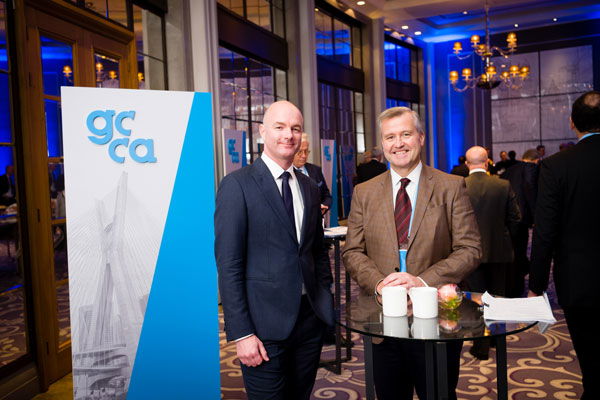The Global Cement and Concrete Association (GCCA) met for its first AGM and symposium at the Corinthia Hotel, London, UK, on Friday, 23 November 2018. With leading CEOs, sustainability, logistics, strategists and co-processing managers, as well as cement and concrete associations in attendance, delegates were informed of an agreed work programme for the GCCA going forward. In addition, the GCCA explained how it will create a voice for the cement and concrete industry, promoting cement as 'the sustainable building material of choice'.

GCCA CEO Benjamin Sporton (left) and President Albert Manifold (right
As the first speaker, Albert Manifold, President of GCCA and CEO of CRH, explained that while the industry was well represented at the national and regional level, this is the first time that a global advocacy body has been the voice for the industry in facing the challenges of sustainability, climate change, population growth and innovation. Although the GCCA is led by CEOs and global industry leaders, it requires input and support at local and regional levels.
The GCCA's membership has been growing rapidly since its creation. At present, the GCCA has a membership representing approximately 35 per cent of the global cement capacity (32 member companies and nine affiliates). The association aims to reach the 50 per cent mark as soon as possible, by which time it believes it will have a solid mandate to be the industry's voice.
Building material of choice
The GCCA's core aim is to make cement the building material of choice and to achieve this, the association is putting the necessary guidance in place for its members to improve their sustainability standards. "For the GCCA to make concrete the sustainable building product of choice, it must highlight its sustainable qualities of durability, productivity, low noise, fire resistance, etc," said Mr Manifold.
He added that five goals to sustainability have been created and form the basis of the association's work programme. The GCCA will work with best practices to safeguard health and safety in both the cement and construction industries. It will also contribute to the debate and discussion of these sustainable goals, particularly in terms of construction and innovation, which will be at the core of the association's activities. Furthermore, it will embrace the principles of the circular economy across the full value chain.
To the next level

GCCA membership represents around 35 per cent of global cement capacity
with key figures attending its first AGM and Symposium
Benjamin Sporton, GCCA CEO, thanked the steering committees for developing the work programme over the last 12 months and Frank Rossini for being GCCA’s acting CEO before Mr Sporton's appointment. Commenting that concrete has a future and is essential to the modern world, Mr Sporton stated the GCCA wants to take that message to the next level – to the UN, development banks and international inter-governmental organisations.
Citing the UN forecast that 1.1bn people will move from rural areas to cities in the next 15 years, Mr Sporton said that concrete will be fundamental in helping to provide shelter, water and food for the growing urban population. The global floor space covered by concrete is expanding at the speed of a new Japan every year, for the next 40 years, and much of that will be in emerging economies. By 2050 more than two-thirds of the population will live in cities and concrete will play a critical role.
Mr Sporton also announced that the World Business Council for Sustainable Development's Cement Sustainability Initiative (CSI) will be taken over by the GCCA on 1 January 2019 and will be further developed to include concrete. The GCCA plans to increase development of innovation in working with organisations such as ECRA and improving best practice by using examples in one part of the world and sharing them with other regions. Carbon capture, utilisation and storage (CCUS) will be an additional focal point as an industry-wide challenge.
Altogether, the GCCA's programme will have six work streams:
1. health and safety in the cement and concrete industries
2. future construction and the role of concrete
3. sustainable value of concrete
4. concrete guidelines
5. cement innovation
6. cement best practices and recording.
Sustainability leadership
GCCA Cement Director, Claude Lorea, spoke about how the association wanted to be a leader in sustainability. She clarified the sustainability charter, which defines the key pillars of the sustainability spectrum for cement and concrete. The charter includes guidance in terms of:
• health and safety
• climate change and energy
• social responsibility
• environment and nature
• circular economy.
Full members will be data monitored and expected to report on their performance and targets in these areas. Members will also be able to apply for extended compliance.
Meanwhile, as part of the work programme, health and safety is seen as a key best practice priority. The GCCA will extend this area to concrete and share knowledge among its members by creating networks and holding annual forums. It will also target hot countries where it will foster more local collaboration, ensuring best practice.
As part of its climate change and energy reduction drive, GCCA also plans a smooth transition for the CSI’s Getting the Numbers Right (GNR) database and the team are currently working on the 2017 round of data collection.
In addition, the association aims to establish best practice and reporting guidelines for health and safety, CO2 reporting, co-processing and water use.
As part of the industry's drive to lower CO2 emissions, GCCA will also provide feedback on cement innovation, alternative binders for low-clinker cements, co-processing, recarbonisation, and CCU and CCS initiatives.
Meeting construction needs & making a convincing narrative
Dr Andrew Minson, GCCA concrete and sustainable construction director and the MPA's executive director, underlined that it was important for concrete to meet the demands of the fast-evolving construction market. Once the evidence base has been gathered from members, the GCCA will be able to write a better story for cement and communicate that concrete is sustainable, innovative and dynamic. It is felt that the word 'resilience' should be added to that as it is a word increasingly used by design teams in construction. Furthermore, the association needs to further explain the benefits offered over the entire product lifecycle. Dr Munson also said cement has to get its own house in order by GNR.
Paul Adeleke, GCCA communications and policy director, added that once the numbers were available, cement has to make a compelling narrative: "We have built the world and can shape it going forwards".
To help bring the message across, the GCCA's website will be improved in the 1Q19 and the social media messages are already being issued. The GCCA wants to create a leadership position for the sector. "It is not just a requirement but an obligation," said Mr Adeleke, "because there is a genuine deficit of trust in organisations and with societies and industries, but by showing that level of openness, innovation and humility we can fill that gap."
Delivering GCCA's aims
Benjamin Sporton returned to the lectern to explain how does the GCCA deliver all this? The association will need good governance, leveraging the broad experience base of its members. Therefore, the GCCA will invite members to take part in the work programmes. In addition, it will create partnerships and stakeholder panels made up of CEOs as well as regional and national associations, proactively sharing ideas and successes. It also wants to establish informal networks of dialogue. "The GCCA aims to be a thought leader," said Mr Sporton.
